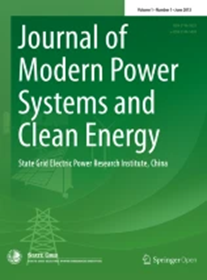基于设备级和场级协同优化的直驱pmsg风电场连接电力系统振荡稳定性控制
IF 6.1
1区 工程技术
Q1 ENGINEERING, ELECTRICAL & ELECTRONIC
Journal of Modern Power Systems and Clean Energy
Pub Date : 2025-04-25
DOI:10.35833/MPCE.2024.001021
引用次数: 0
摘要
现有的亚/超同步振荡稳定性控制方法主要集中在离散频率下的特定运行条件,限制了它们对与直接驱动永磁同步发电机(PMSG)风力发电场连接的电力系统的各种振荡情况的适应。在补充耗散补偿的基础上,提出了一种结合设备级和农场级协同优化的振荡稳定控制方法,以提高系统级稳定性。首先,分析了动态自耗散和动态耦合耗散对系统稳定性的影响,建立了补充耗散补偿的基本原理。随后,基于临界控制,确定了补充耗散补偿的最优位置,增强了动态自耗散效应,抑制了动态耦合耗散效应。在此基础上,考虑了风电场-电网和pmsg间联合作用下的能量需求,平衡了风电场-电网相互作用耗散能和pmsg间相互作用耗散能分布,建立了设备级控制参数优化算法和电场级电力协同优化算法。最后,仿真结果表明,动力耦合耗散是振动产生和发展的根本原因。通过设备级和农场级的协同优化,该方法能够可靠地补偿动态耗散能量,同时适应振荡频率的变化和振荡场景。它可以最大限度地提高互联系统的能量耗散效果,实现对亚/超同步振荡的快速抑制。本文章由计算机程序翻译,如有差异,请以英文原文为准。
Oscillation Stability Control Based on Equipment-Level and Farm-Level Cooperative Optimization for Power System Connected with Direct-Drive PMSG-Based Wind Farms
Existing sub-/super-synchronous oscillation stability control methods are primarily focused on specific operating conditions at discrete frequencies, limiting their adaptation to varying oscillation scenarios in the power system connected with direct-drive permanent magnet synchronous generator (PMSG)-based wind farms. Based on supplementary dissipation compensation, this paper proposes an oscillation stability control method incorporating equipment-level and farm-level cooperative optimization to enhance the system-level stability. First, the effects of dynamic self-dissipation and dynamic coupled dissipation on system stability are analyzed, establishing the foundational principle of supplementary dissipation compensation. Subsequently, the optimal locations for supplementary dissipation compensation are identified based on critical control designed to enhance the dynamic self-dissipation effect and suppress the dynamic coupled dissipation effect. Furthermore, by considering energy requirements under the combined wind farm-grid interaction and inter-PMSG interactions and balancing the wind farm-grid interaction dissipation energy with inter-PMSG interaction dissipation energy distribution, an equipment-level control parameter optimization algorithm and a farm-level power cooperative optimization algorithm are established. Finally, the simulation results demonstrate that dynamic coupled dissipation constitutes the root cause of oscillation inception and progression. Through equipment-level and farm-level cooperative optimization, the proposed method can reliably compensate dynamic dissipation energy, while adapting to the variation of oscillation frequency and the oscillation scenario. It can maximize the energy dissipation effect of the interconnected system, achieving rapid suppression of sub-/super-synchronous oscillations.
求助全文
通过发布文献求助,成功后即可免费获取论文全文。
去求助
来源期刊

Journal of Modern Power Systems and Clean Energy
ENGINEERING, ELECTRICAL & ELECTRONIC-
CiteScore
12.30
自引率
14.30%
发文量
97
审稿时长
13 weeks
期刊介绍:
Journal of Modern Power Systems and Clean Energy (MPCE), commencing from June, 2013, is a newly established, peer-reviewed and quarterly published journal in English. It is the first international power engineering journal originated in mainland China. MPCE publishes original papers, short letters and review articles in the field of modern power systems with focus on smart grid technology and renewable energy integration, etc.
 求助内容:
求助内容: 应助结果提醒方式:
应助结果提醒方式:


